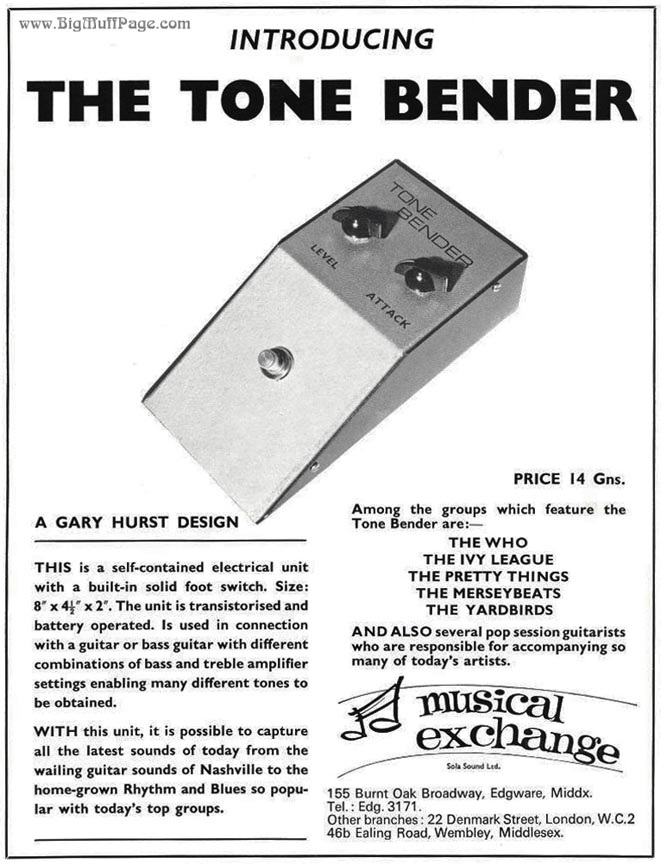The Tone Bender Timeline
VISIT MY SWORDS, KNIVES and FANTASY ART WEBSITE www.kitrae.net
This page is periodically updated to reflect new information. Do not reprint or repost without permission.
©2009 Kit Rae. Last update October 2015.
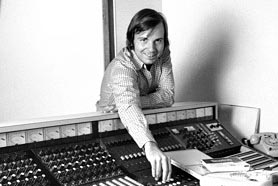
Electronics Engineer Roger Mayer
•1964 (probably late in the year) - Roger Mayer, a young man working for the Admiralty Research Laboratories in Teddington, makes his first fuzz pedal for session guitarist Jimmy Page, an improved version of the Maestro Fuzz Tone. According to Roger he also made fuzz pedals for guitarists Jeff Beck, and Jim Sullivan, another session guitarist working the same circuit as Jimmy at the time. Both Jimmy Page and Jeff Beck have confirmed that Roger Mayer did make a fuzz pedal for each of them. According to Mayer, he was friends with Page and used to go to his house, or Page would come to his, and they listened to American records. Mayer has also claimed he produced a treble booster that was tried and used by his friends, including Page, in 1961. Page had just joined his first band in 1961, the Crusaders. The first popular treble booster, the Top Boost, was actually created in 1961 by Vox for the AC-30 amp, which sparked a host of makers later creating treble boosters. It is interesting that Mayer claims he also made one the same year, especially when his website states he first began making guitar effects much later, in 1964.
Here is Jimmy Page's recollection of his Roger Mayer fuzz box from the film It Might Get Loud, Jimmy states: "Knowing that there was a threshold in volume, I wanted to get more sustain out of things. I'd bumped into this chap, Roger Mayer...'did I have any ideas?' I had this record at home of a guitar that had a lot of sustain on it, and I got him to come down and have a listen to it, and I said, 'can you get that?'. And he went away, and came back with this phenominal thing." In a 2014 interview for Absolute Radio Page stated that he made sure Jeff Beck got the second Mayer fuzz box made. In a 1977 interview Page elaborated more on the development - "Anyone who needed a guitarist either went to Big Jim (Sullivan) or myself.... It was all just flooding in because they didn't have any other young guys playing guitar. I had just started to do a few sessions (reports vary, but Jimmy began session work in 1961, then heavily through 1964-65, ending Spring 1966) and he (Mayer) said, 'I work for the Admiralty in the Experimental Department and I could make any sort of gadget you want'. So I said why didn't he try to make me this thing I'd heard years before on this Ventures record, 'The 2000-Pound Bee'. We had one in England, but it wasn't too good. In actuality it was a disaster. So I said, 'Why don't you improve on this with the Admiralty's facilities?' Which he did." The Ventures actually used a hand made fuzz box on that tune, but Page is thinking they used, and is referring to, a Maestro Fuzz-Tone, the only production fuzz pedal available in America at the time.
This is Roger Mayer's recollection - “The first pedals that I made for Page and Beck ran off a six-volt battery and were housed in a custom-made casing. There were controls for gain and biasing as well as a switch that modified the tonal output. They were rather unlike the pedals that you see today in that they had a separate foot switch attached to the box by a length of cable. I built a treble booster for Jeff Beck, and I was told that he borrowed Page’s fuzz box for some of the Yardbirds’ stuff.” Mayer has also stated: "The one I originally built for Page was loosely based on the Gibson Maestro". "Right from square one, Pagey and I wanted something that sustained a lot, but then didn't start jittering as it went away. One of the things that became very, very apparent early on was that you didn't want nasty artifacts. It's very easy to design a fuzz box' - anybody can do it - but to make one sound nice and retain articulation in notes, now that's something else."
Another Mayer quote from an Iconic Axes interview in 2012: "...I never saw a Gibson Maestro first of all. I’ve never had one in my hands, in fact, to date; I’ve never had one in my hand [laughs]. We listened to the sound of it you see, on the early Ventures records. I think they had a record out called “The 2000 Pound Bee” and it seemed like an interesting sound. The problem with the early Maestro fuzz tones were I guess quite percussive in nature; they didn’t have a lot of sustain. So I built, when I was working with the Admiralty, a version of a germanium fuzz box loosely based on the Maestro. It gave more sustain and it had a richer sound. That became quite popular amongst the session players around London. Big Jim Sullivan used it on a couple of Proby records. The Nashville Teens had one, Jimmy Page had one, Dave Dee, Dozy, Beaky, Mick & Tich, I think Ritchie Blackmore. There wasn’t that many, I didn’t really make that many of them, only for the session guys and a few bands."
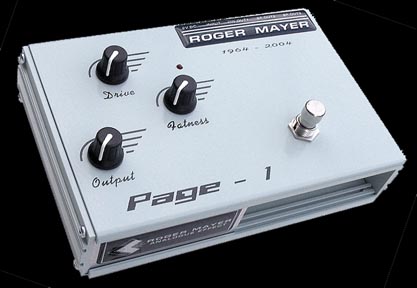
The Roger Mayer Page 1 from 2004, supposedly a replica of the first fuzz pedal he made for Jimmy Page. The original did not look like this or have a Fatness knob.
Note that Mayer states he never had a Gibson Maestro in hand, then says his circuit was loosely based on it, which seems to be a contradiction. In Martin Power's book Hot Wired Guitar it states Mayer did borrow the configuration from the Maestro. Here are some relevant quotes from the book: "Jimmy came to me when he got a hold of the Maestro fuzz and said 'It's good but it doesn't have enough sustain...it's a bit staccato.' I said 'Well, I'm sure we can improve on that...That conversation spurred me to design my first fuzz box." "There had to be similarities of course (to the Maestro), because there were only three terminals to work with, bit I managed to build one that had much more sustain." Examining his Page-1 fuzz circuit, a pedal he began selling in 2004 that was supposed to be an improvement upon his original Page fuzz, it does loosely resemble the Gibson Maestro FZ-1, but it also resembles the Tone Bender MKII circuit.
Mayer has at times stated his fuzz box was used by Jim Sullivan for the recording of the hit Hold Me by P.J. Proby, however Jim Sullivan has stated it was a Maestro Fuzz-Tone he used, borrowed from Eric Ford. I have also never found an interview with Sullivan where he mentions Roger Mayer or a hand made fuzz, but there are many where he references using an FZ-1. Often times these makers create a fuzz box for a certain musician, then hear a fuzz effect on the record and assume (or hope) it was their device, but no one really knows for sure what was actually used in the studio other than the people who were there at the time.
Roger Mayer famously went on to work with Jimi Hendrix in 1967 and 1968, modifying existing effects and creating new effects pedals for him, and referred by the Jimi The Hendrix Experience as their 'secret weapon'. He is credited as the designer of the first Octavia effect.
•1964 March - Jimmy Page plays heavy fuzz tone guitar on the Carter-Lewis and the Southerners song Skinny Minnie, recorded March 27, 1964. It is unknown if the fuzz box used was a Maestro Fuzz-Tone, or the custom made Roger Mayer fuzz box, but it sounds like a Fuzz-tone.
•1964 September - Gary Hurst is hired to work for the Elka organ company, and travels to Italy. While there, he helps Elka design the Capri organ, as well as to doing some research for JMI/Vox on solid state amplifiers. Elka would later get into the effects pedal business.
•1964 October - Jimmy Page plays fuzz tone guitar for producer Shel Talmy on The Who's Bald Headed Woman, the B-side to the I Can't Explain single. Jimmy was one of the few guitarists in London at the time who owned a fuzz box. Shel frequently used Jimmy as a backup guitarist for his sessions. The song was written by Talmy and included as a B-side so he would get a royalty payment on the single. This was simply the way producers worked at the time (Talmy had the Kinks record the same song for one of their B-sides). Who bassist John Entwistle confirmed Page's playing on the liner notes to The Who's Two's Missing compilation in 1987: "The fuzz guitar droning throughout is played by Jimmy Page. The reason being, he owned the only fuzz box in the country at that time."
Reportedly, Shel got Page to play lead guitar because Pete Townshend did not own a fuzz box. Sessions are said to have occurred in October 1964. It is unknown if the fuzz box used was a Maestro Fuzz-Tone, or Jimmy's custom made Roger Mayer fuzz box.
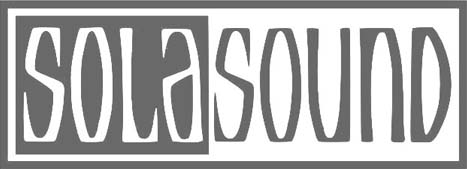
•1964 December - Larry and Joe Macari form Sola Sounds Limited (based on original bank notes from 1964). The new brand was to be used for a range of exclusive products made for and sold by the Macaris Musical Exchange shops, as well as distributing nationwide. The line started with fuzz and effect pedals, later expanding into amplifiers, mixers, spring reverbs, and microphones under their Colorsound brand, among other musical products. Advertisements in 1965 show the name as Sola Sound Ltd and Solor Sound Ltd. Sola was intended to be a play on the word Solar, but spelled the way it is pronounced with a British accent.
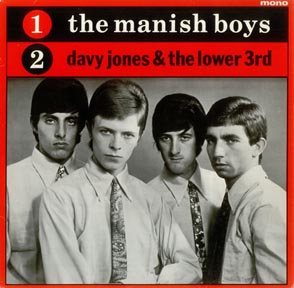
•1965 January - Jimmy Page uses the Roger Mayer fuzz box in a January 15, 1965 session in London, playing on two tracks for the Mannish Boys, an early David Bowie band, back when he was just 17 and known as David Jones. Bowie and others have stated that Page just got this new fuzz box at the time, which was likely the hand made fuzz effect Roger Mayer made for him in late 1964.
Reportedly the band rehearsed the song I pity the Fool (written by Bowie) at a coffee bar before the session, where they were introduced to Page, who was scheduled to play on the session. Page mentioned he was bringing his "brand new fuzz box" to the session. In a 1997 interview Bowie sated "He was wildly exited about it". Some sources state this was a Tone Bender, and Jimmy mentions having a hand made Tone Bender in a 1968 Hit Parader interview (Gary Hurst is credited as the maker in the piece). However, the fuzz used on this session was the fuzz box hand made by Roger Mayer in 1964. The wood boxed Gary Hurst Tone Benders did not exist yet.
Here is a quote from Bowie on the session, indicating the fuzz box was only recently aquired: "When I was a baby, I did a rock session with one of the bands, one of the millions of bands that I had in the '60s – it was the Manish Boys, that's what it was – and the session guitar player doing the solo was this young kid who'd just come out of art school and was already a top session man, Jimmy Page. And he just got a fuzz box and he used that for the solo. He was wildly excited about it, and he was quite generous that day and he said "Look, I've got this riff but I'm not using it for anything so why don't you learn it and see if you can do anything with it." So I had his riff and I've used it ever since [laughs]. It's never let me down." Bowie did use the riff for The Supermen on his third album The Man Who Sold The World, then again in 1997 in the song Dead Man Walking from his Earthling album.
•1965 - Jimmy Page, at the age of 21, is asked to join the Yardbirds to replace Eric Clapton, at Clapton's suggestion. He had a good paying job doing session work around three times a day, five days a week, so he declines. He recommends his close friend Jeff Beck for the job. Jimmy reportedly takes job as staff producer for Oldham's Immediate Records in 1965.
•1965 Spring - JMI/Vox and EKO set up a factory in Recanati Italy to help meet the demand for Vox guitars.
•1965 - Jeff Beck plays his first live gig with the Yardbirds.
•1965 - Vox/JMI engineer and Vox Distortion Booster designer Dick Denney claims that he personally delivered Vox Tone Bender prototypes to the Beatles in early 1965. Reg Clark of Vox had established a prior relationship with the Beatles to supply them gear to use in public in return for letting Vox use their images in marketing materials. What these "Tone Bender prototypes" were is unknown, since Gary Hurst did not start building his first Tone Benders until April, and the Vox branded Tone Benders were not made until 1967.
•1965 April - In April Gary Hurst returns to London after working in Italy for Elka, and resumes his freelance electronics business, "Gary Hurst Electronics", from the back of the Macaris Musical Exchange shop on Denmark Street (Note some sources state that, with the help of Vox sales manager Reg Clark, Gary was given work space in the back of the JMI/Vox shop at 100 Charing Cross Road, not the Macaris shop)
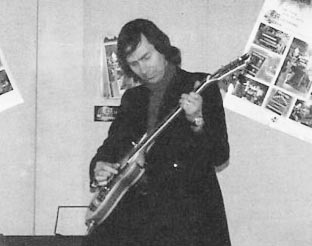
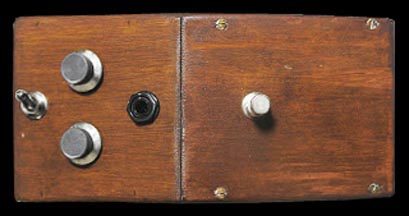
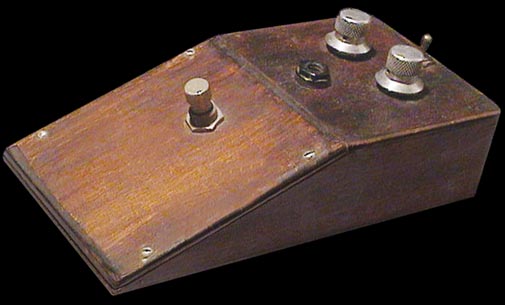
Gary Hurst and one of the first hand made Tone Benders
• 1965 April - The very first Tone Bender is hand made by Gary Hurst. The Tone Bender is another three-transistor circuit based on the Maestro Fuzz-Tone FZ-1, with a few additional components and minor value changes to increase the voltage and add more sustain. It was one of the first pedals to feature true bypass switching. Gary admits he copied and modified the Fuzz-Tone circuit, while allowing the Tone Bender advertisements to state "A Gary Hurst Design". He followed this practice in later years as well, making modifications and adjustments to existing circuit designs to alter the sound, and naming himself as the designer. Gary (or Sola Sound via their later advertisements) was actually one of the first engineers to promote his name to the public as an effects pedal designer. Note that copying and modifying these simple amplifier circuits was common at the time, and similar amplifier circuit topology already existed in GE and Mullard transistor manuals specifically for this purpose (and to sell more transistors!). It was not really theft so to speak, no more than any auto maker back in the heyday of automobile manufacturing was "stealing" by making their own version of the gasoline powered combustion engine. The FZ-1 Gary copied was not completely original either. Similar hand made fuzz circuits already existed and were in use in recording studios prior to the FZ-1 production. What Gary did here was basically to modify a known circuit, which was itself a variation on existing circuit design.
Gary states that in early 1965 he built the original wood cased Tone Benders in the back of the Macaris’ 22 Denmark Street shop, and at home in the evenings (Note, some sources state he made them above the Macaris shop at 100 Charing Cross Road, but that was still the address of the Vox shop in 1964, and the Macaris did not move into that address until the Vox shop closed, in 1967). Larry Macari was paying Hurst for each unit, one at a time, as they were made. Gary has stated he made about ten wood boxed Tone Benders a day for a few weeks, probably less than 100 units in all (he states 68 units in a Guitarre magazine interview), and all were sold through Macaris. Anthony Macari strongly dsputes those numbers and thinks only around 20 were made in the wood box. Gary custom made some of these for top musicians in London, like Jeff Beck (the Yardbirds), Jimmy Page, and Mick Gee (Tom Jones band), prior to them being offered to the public. Jeff beck confirmed he had one on April 20th. An interview with Jimmy Page from this time period seems to confirm that shortly after Jeff Beck got his, Page got one. These artists were also listed as users in the Tone Bender advertisements from the time.
In 2000 Gary told the story about the origin of the Tone Bender in Kevin Bacon's book, Fuzz and Feedback, and in a Guitarre magazine interview from 2003. It is also included in Gary’s four page “Tone Bender Fuzz Unit Story as told by Gary Hurst” included with his hand made Tone Benders in 2005. He states that in April 1965 Guitarist Vic Flick brought a Maestro Fuzz-Tone to Macaris Music Exchange on Denmark Street to have it modified. Vic was an acclaimed and in-demand English session guitarist at the time, famous as the player of the James Bond theme for the film Dr. No in 1962, lead guitarist of the John Barry Seven, a member of the Beatles' Hard Days Night soundtrack orchestra in 1964, as well as session guitarist for numerous other recordings with British pop stars, including Tom Jones.
According to Gary, Vic wanted something that could do the same thing as a saxaphone, like the horns section that fills in the gaps in a Tom Jones' song. He could not do that with the Maestro because the fuzz was short and raspy sounding. It woud fart a note and that was it. He wanted longer sustain (a common complaint about the Fuzz-Tone at the time). Gary states it was impossible to change the Maestro because it was only fed 3 volts. He claims he told Vic he could build him a better one, and that became the circuit the original Tone Bender was based on. Gary simply took the Fuzz-tone circuit and increased the bias from 3 volts to 9, and tweaked a few component values. Although they still sound very similar, the difference in sound is very apparent when playing the two side by side. This modification allowed notes to be sustained for up to twenty seconds according to Gary. He said Vic enthusiastically left the shop with this improved version, which was housed in a wood box. Gary has told this story on many occasions, and claims he still owns Vic's original Maestro Fuzz-Tone, since Vic did not ask for it back.
In early 2013 I asked Vic Flick about his recollection of his custom made fuzz box. He said he had only recently been made aware that Gary and JMI were still using his name in the promotion of their Tone Bender replicas with this story, was never contacted by them about it, nor had he granted them permission to do this. Vic did state he remembered being in Macaris often and talking about the limitations of the Fuzz Tone. He knew there was a person making fuzz pedals in the back of the shop, but did not know his name. Surprisingly, he said he does not remember asking anyone there to modify his Maestro Fuzz-tone, nor why he would have wanted it modified. He also said he is still in possession of his original Fuzz-Tone. It is pictured on top of his Vibrolux amp (shown below) in a photo that has been on Vic's website since around 2003, and shown in his 2008 autobiography, Vic Flick: Guitarman - From James Bond to the Beatles and Beyond. This seems to be a straight contradiction of Gary's story. It is also worth noting that fuzz collector Graham Green claims he has seen email correspondence circa 2000 between Gary and Vic that does confirm Gary's original account, although I have never seen these emails. Vic told me he first became aware of Gary's claims in 2007 when being interviewed for a story.
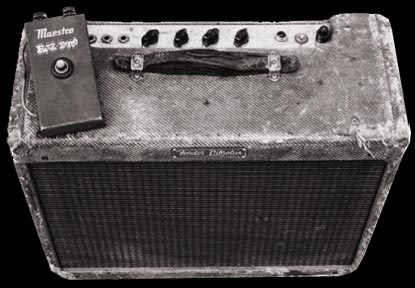
Vic Flick's Fender Imbroglio amp and his original Maestro Fuzz-Tone
Assuming memory has not failed either Vic or Gary (can't blame them - this was a long time ago!), there is another explanation for this contradiction. Gary is simply confusing Vic Flick with another session guitarist in London from that time. Jim Sullivan was one of the top session guitarists, who was also known to own a fuzz pedal in 1964 or '65, as was Jimmy Page. This is pre Yardbirds, so Page was not yet a well known name to the public. Both Jim Sullivan and Jimmy Page were very in-demand session guitarists, along with Vic Flick, Eric Ford, and others in the 1964-65 period the Tone Bender would have been developed. They all knew each other, played the same sessions together occasionally, and reportedly the two Jims even borrowed each others gear from time to time. Both were favorites of producer Shel Talmy. Sullivan and Page played together on a Brenda Lee session in August 1964. On one occasion, Sullivan, Page, and Vic Flick all played on the same session together at Decca studio 2 in North London. To avoid confusion of the two 'Jims', Sullivan was nicknamed 'big' Jim, and Page 'little' Jim. Big Jim and Vic both owned Fuzz-Tones, as did Page, who also owned a hand made Roger Mayer fuzz box. Gary always mentions Vic Flick as the creator of the James Bond theme when telling this story, so he clearly knew which one Vic was. That said, each of those session men frequented Macaris, and this does seem to be a case of confusing one session guy for another. Read on.
In 2009 Jim Sullivan was being interviewed for a magazine article, and when asked about fuzz pedals, he recounted a similar story to the one Gary Hurst tells, although it was him who brought the Fuzz Tone to Gary. He recalled hanging out at the Vox shop and being friends with the tech who worked in the back. He thought the Fuzz Tone was "an expensive farting noise box" and remembers loaning the tech his Fuzz Tone and never getting it back, but being given a new fuzz box. "I was given a wooden (and then metal) boxed foot pedal made by a friend I had that I took my gear to, to get fixed. He had a space in the old Vox store…I asked if he could make it (the Fuzz-Tone) sound like a sax so I could better fit into the horn section of a Big Band style project I was touring with at the time...". When asked if this tech's name was Gary Hurst, he confirmed it was. Every detail in Gary's story is accounted for here, it just seems he had the wrong session guy on his mind. With that, we now have the correct account of the real origin of the first Tone Bender! (Big thanks to theemadcap1 from the D.A.M. forum for helping to solve this mystery, recounting his interviews with Jim and Vic, and the quotes)
There is also some contention about the date the first Tone Bender was built. Gary has stated on several occasions that he made the first Tone Benders in early 1965, after his return from Italy. Jeff Beck had one by April 20th. Two magazine articles from the time imply this date was either in 1964, prior to September, or after Gary returned from Italy in April 1965. Beat Instrumental was one of the UK's leading monthly music magazines, covering the growing rock scene throughout the 1960's and 1970's, along with its weekly competitor, the Melody Maker newspaper. BI and MM featured interviews with the top musicians, covering everything from the gear used to the studio production methods. The latest gadgets were always talked about here, and BI was where you would find the advertisements for all of those gadgets. Hit Parader and New Musical Express were two other popular music newspapers in the UK, although they were less focused on gear. An article in the September 1965 issue of BI about the new Tone Bender's being made by Sola Sound states this: "Gary Hurst is the technician behind the new fuzz box, he calls it the Tone Bender. He perfected it last year but had to shelve it when he went to work with an Italian firm making organs." 'Last year ' would be 1964, incorrectly indicating that Gary made the first wood boxed Tone Benders in 1964, before going to Italy, not in 1965.
However, an article from the weekly Melody Maker newspaper in late 1965 or early 1966 states this quote from Larry Macari: Electronics consultant Gary Hurst was the first to design a British model, which was manufactured by Musical Exchange of London..."we decided to build our own, with a better circuit. This happened about eight months ago and we started selling about 20 to 30 a week. We decided to go into production." Since this press release article was likely not printed earlier than September '65 (when the TB MKI was first advertised), Larry Macari saying 'eight months ago' places the wood boxed Tone Benders in early 1965, not 1964 as the Beat Instrumental article implies.
Larry Macari also states a different origin for the Tone Bender in that Melody Maker article: Exchange managing director Larry Macari told the MM: "The first American tone benders had no sustain - you couldn't sustain the distortion effects. Where I worked we loaned out an American unit (the Maestro Fuzz-Tone, the only production American unit available) for record sessions. When this got faulty we decided to build our own, with a better circuit. This happened about eight months ago and we started selling about 20 to 30 a week. We decided to go into production. It has sold hundreds and records by groups like the Yardbirds and Merseybeats, have helped enormously. There have been fuzz records by Spencer Davis, The Walker Brothers, Pretty Things, Who, Ivy League, and Dave Dee. We sent one over to Tom Jones in the States. Jeff Beck of the Yardbirds used one with his bottle-neck and gets a sound like violins - really tasteful.". Note that Larry's version of the original Tone bender origin is the Musical Exchange needed a replacement for their faulty Maestro Fuzz-Tone, so they built one. Also note that there is no mention of Gary Hurst, even though his name was being used in the advertisements at the time. Strange contradictions, but editing can often change the meaning of what was actually said. All we can get from this is that the first Tone Benders were built by Gary sometime in this period. It is also interesting that 'tone bender' was used generically in this article as a term for any fuzz pedal. It is unclear who first came up with the name Tone Bender, but the Macaris owned the rights to it at the time.
One funny quote from that MM article: Warns Steve Winwood: "It should be used sparingly. It's a good commercial sound but you've got to look after them. If you leave the button down and pack it away the battery keeps going and the next time you want to use it, the battery's flat."
•1965 April - Jeff Beck joins the Yardbirds after being recommended by friend Jimmy Page. He uses his hand made Gary Hurst MKI Tone Bender fuzz box on the Yardbirds single Heart Full of Soul, recorded on April 20th, 1965. Sources vary about which fuzz box this was, and Gary Hurst has stated he thinks it was his Tone Bender, but also states "I could be wrong, but I think he used Jimmy Page's Tone Bender... Forty years have passed it is difficult to remember so well." Other accounts state it was Jimmy Page's hand made Roger Mayer fuzz box. Some digging sorted out the confusing accounts and brought out the real story. In fact, the pedal on the record is a Gary Hurst MKI Tone Bender.
A tabla and sitar player had been used to record the main riff on the Heart Full of Soul track before Jeff arrived in the studio, but these Indian musicians could not follow the 4/4 time signature of the song. Beck thought he could do a better job with the riff using his guitar. Jimmy Page was also in the studio at the same time doing session work, so Beck borrowed Jimmy's Roger Mayer fuzz box to work out the main riff. However, that is not the pedal heard on the recording. Mark Brend interviewed Yardbirds manager Giorgio Gomelsky for his book Strange Sounds-Offbeat Instruments and Sonic Experiments in Pop, who had this to say about the session: "Our friend Jimmy Page was visiting us…so he and Jeff got an amp set up in the bathroom of the studio, the only place available, in an attempt to come up with some trickery to imitate the sitar sound on a guitar, and every ten minutes or so I would check up on how they were doing. Time was running out and we needed a bit of luck. Miraculously, Jeff came up with something we could use, and we politely parted company with the rather puzzled Indian musicians - who had never been in the studio before - but not before Jimmy, wildly enthusiastic about the sounds emanating from it, bought the sitar from them for 25 pounds!
In Brad Tolinski's book Light and Shade: Conversations with Jimmy Page, Beck and Page were both interviewed at the same time, and Beck clarified exactly what was used for the session: "Jimmy was actually in the studio at the time, and I borrowed his Roger Mayer fuzz box to work out the idea. Then, when I went to record my part later, I used a Sola Sound Tone Bender, which was one of the first fuzz boxes available commercially." Note that Page has stated that he made sure Beck got the second Roger Mayer fuzz box made, so that must have occurred sometime after this session, but this confirms the date the MKI Tone Bender was first on the market, and confirms that Page apparently did not have one yet, since he was still using the Mayer fuzz.
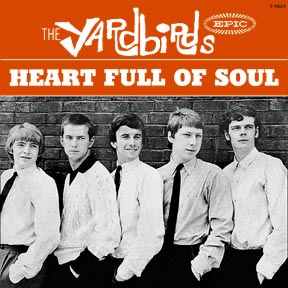
•1965 June - Yardbirds single Heart Full of Soul, released in the UK June 1965 and in the US July 1965, marking the beginning of the rock and roll fuzz tone era in the UK. It reaches #2 on the UK singles charts.
•1965 June - Keith Richards records the Rolling Stones #1 hit (I Can't Get No) Satisfaction with the Maestro Fuzz-Tone (FZ-1) on May 10, 1965 in RCA Studios, Hollywood, California. It was released in the US in June 1965, marking the beginning of the rock and roll fuzz tone era in America. By July it held the #1 spot on the US Billboard charts, and stayed there for four weeks straight. It was the first #1 hit in the US charts for the Stones. Satisfaction shook the fuzz tone world, and to this day it is still considered one of the greatest rock 'n' roll songs of all time. Although Richard's has stated he did not like the Fuzz-Tone effect, he did use it when performing Satisfaction on-stage, and it was used again later on the Stones track Think, recorded December 1965 for the Aftermath album. A report in the February '66 issue of Beat Instrumental states that Gibson sent the Stones several Fuzz-Tones because Keith often trampled them with his big boots on stage.
Here is a quote by Keith from a 1992 interview in Guitar Player by Jas Obrecht: "Oh, vintage fuzztones? Well, there's the first one (points to the Colorsound Tone Bender). But where's that @#$%& "Satisfaction" one? They bunged me. I mean, it was a miracle. Whatever it was, it was the first one Gibson made. I was screaming for more distortion: "This riff's really gotta hang hard and long," and we burnt the amps up and turned the shit up, and it still wasn't right. And then Ian Stewart went around the corner to Eli Wallach's Music City or something and came around with a distortion box. "Try this." It was as off-hand as that. It was just from nowhere. I never really got into the thing after that, either. It had a very limited use, but it was just the right time for that song. The riff was going to make that song or break it on the length that you could drag that [sings fuzz line]-unless you wanna get horns, which didn't work. We didn't have the time, and it wouldn't sound right. Yeah, it was one of those fortuitous things."
NOTE - The event of the release of Heart Full of Soul and Satisfaction, while certainly not the only factors (The Kinks, Peter Green and Eric Clapton being just a few of a handful of others), were perhaps singularly responsible for the beginning of the explosion in the effects pedal business in the UK and in America. What young guitarist could not imagine himself playing the riff from Satisfaction after hearing it for the first time? Budding guitarists everywhere wanted to create those same sounds, and there was a huge influx of young people learning to play the guitar because of the escalating music scene. From 1965 through the early 1970's, expansion in the UK effects pedal business seemed to move incredibly fast, with new products coming out monthly, if not weekly. Much of it involved copying or slightly modifying pre existing effects circuits, whether they be fuzz or modulation type effects. Effects makers were even painting or covering their circuits with epoxy to hide the circuits from competitors looking to copy them, or hiding the fact that they themsleves were copying another circuit. Most of the core circuit designs for all areas of the guitar effects spectrum that are still going strong today were developed in this time period. They would be refined and further developed throughout the 1970's, but the seeds were all planted in this short span of a few years. As anyone who has studied effects pedal schematics will find, there are very few truly original circuit designs. Most are simply reworkings of what was created in the 1960's and 1970's, and much of that, at least in the fuzz pedal area, was based on preexisting amplifier circuit designs from General Electric and Mullard transistor manuals from the 1950's and 1960's.
There appears to have been much competition and plagiarism among the various players in the UK effects industry, paralleled in America, but many of these companies were also very intertwined together in business relationships (Vox and Macaris Musical Exchange, for example), and the personnel involved crossed from one company into another often (Gary Hurst and Dick Denney, for example). Effects pedals were in huge demand and would be flying off the shelves as soon as they were made, prompting many companies to expand and outsource production to meet the demand. Every company was watching what the other was doing closely, trying to stay on top of the trends, and there was a lot of re branding and repacking of the same effects for multiple shops. Trying to sort out who did what and when these days is a confusing mess, but it is also what has made the history so colorful and interesting to effects aficionados.
•1965 (mid year) - Larry Macari partners with Gary Hurst to have MKI Tone Benders manufactured for Macaris Musical Exchange. The Macaris created the Sola Sounds brand the previous year, so the pedal is manufactured as the Sola Sound Tone Bender sometime in mid to late 1965. An article in the September issue of Beat Instrumental (probably written a few months earlier due to typical timeframe to edit, print, and distribute) makes the mention of Gary Hurst and his Tone Bender, stating "We can report now there is a unit being sold in London now and that nationwide distribution is being arranged."
•1965 June/July – Sola Sound MkI Tone Bender (sheet metal enclosure) in pre production or possibly in production, built in the back of the Macaris' Denmark Street shop. According to Gary Hurst in the September '65 issue of Beat Instrumental magazine, the Sola Sound MKI Tone Bender started production a few months after his return from Italy, which would be June or July, possibly later. This would indicate the TB was the first true production fuzz pedal made in the UK. Even though it was shown earlier, the Vox Distortion Booster was apparently not actually in stores until October or November due to production delays.
•1965 late - Maestro Fuzz-Tone (FZ-1A) on market, made in Kalamazoo, Michigan. A revised version of the 1962 Maestro Fuzz-Tone (FZ-1). All of the old FZ-1 stock had sold out near the end of 1965 due to the popularity the Rolling Stones #1 hit Satisfaction, which features the Fuzz Tone effect for its main guitar riff, so Gibson returned to production with this version. For some reason Gibson decided to revise the circuit, changing from the two battery 3v to an even lower powered single battery 1.5v circuit. Many players preferred the original version. Based on serial numbers, Gibson went from making and selling zero Fuzz-Tones in 1964, to over 3000 in 1965, and over 20,000 units in 1966. By 1969 they had sold over 45,000 units.
•1965 (before November) - Vox/JMI engineer Dick Denney visits Thomas Organ Lab company in California/USA. Maestro Fuzz-Tone (FZ-1A) version was on the market in the USA at this time.
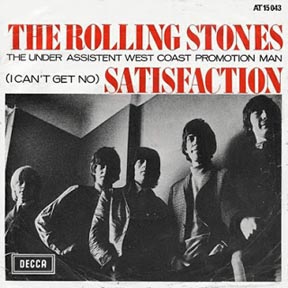
•1965 August - The Rolling Stones song (I Can't Get No) Satisfaction is released as a single in the UK. By September it had reached #1 in the UK charts and stayed there for two weeks.
•1965 August - Vox Distortion Booster first shown. Designed by Vox/JMI engineer Dick Denney. First shown publicly in August 1965, listed in the US Vox September 1965 price list (as model number V87, and V816 in the UK Vox catalog), and in stores by November/December. In the October '65 issue of Beat Instrumental there is an article on the Musical Instruments Trade Fair, which started August 23rd, 1965, in London. "Fuzz boxes were surprisingly plentiful. Watkins showed their Pep Box at 16 gns, Barnes & Mullins had the Tone Bender at 14 gns, and Vox showed what they call a distortion booster, one of a range of input attachments which they have recently brought out. As well as the distortion booster, there is a bass booster, a mike booster and a treble booster all at 14 gns."
•1965 September - The Sola Sound MKI Tone Bender on market. It was being advertised in print by September 1965, shortly after Heart Full of Soul and Satisfaction are released in the UK. Ads promote Gary Hurst as designer. This semi-production version of Gary Hurst's modified Maestro Fuzz-Tone is housed in a folded sheet metal enclosure, rather than wood like the originals. It was assembled in the back of the Macaris Musical Exchange shop and sold exclusively through the storefront. The lettering was hand pressed on early pedals by Gary's girlfriend Rosita (daughter of Larry and Joe Macaris' sister Rosa) using Letraset press on letters, then coated with nail polish. A few different Letraset fonts were used, then the art was changed to a silk screen with the Sola Sounds branding. Around 100 of them were made and only a handful of these are known to still exist today. Some of the surviving examples have a paint or epoxy coating covering the circuit components, presumably to hide the circuit from competitors interested in cloning it. Early Letraset units had no Sola Sounds branding. Some of the very first units also have no battery door on the bottom as later units had.
An “Instrumental Corner” article in the September issue of Beat Instrumental (probably written a few months earlier due to typical delay timeframe to assemble, print, and distribute) referencing Gary as the Tone Bender designer states this: "Gary Hurst is the technician behind the new fuzz box, he calls it the Tone Bender. He perfected it (this would be the wood boxed version) last year but had to shelve it when he went to work with an Italian firm making organs. He started making his Tone bender in large quantities as soon as he came back to this country a few months ago, and is now selling them through the Musical Exchange Shops in the London area. He says he is sorry in a way that he went to Italy because the current in-trend then was R&B and his Tone Bender would probably have gone a bomb with guitarists who were searching for new, earthy sounds.". A ‘few months after his return’ from Italy would be around June or July, so that is likely when the Sola Sound version was beginning to be set up for production at Macaris.
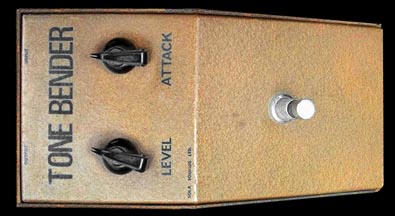 ..
.. 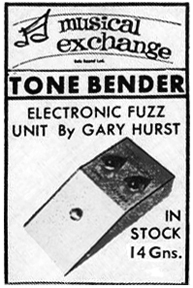
The September Beat Instrumental ad for the Tone Bender lists several artists who were using Gary's early wood boxed version of the MKI, including The Who, The Ivy League, and the Yardbirds. Musical Exchange/Sola Sound addresses listed on ad: 22 Denmark St, London W.C.2. / 155 Burnt Oak Broadway, Edgware, Middlesex / 46b Ealing Road, Wembley, Middlesex. Note there is no 100 Charing Cross Road address listed, indicating that address was still the Vox shop at this time, but Larry Macari was apparently still working there as the sales manager.
•1965 September - The Thomas Organ Company begin to make Vox amplifiers in the US, in the Los Angeles suburb of Sepulveda. Tom Jennings expresses his dislike in having Vox amplifiers made in the US. Soon after these tube amps were changed to solid state circuits, cheapening the brand in Tom's opinion.
BACK TO THE FUZZ AND MUFF TIMELINE
Website and contents ©2007 and ©2014 Kit Rae. All rights reserved. Linking to this website is allowed, but copying the text content is strictly prohibited without prior authorization. No part of this work may be reproduced, stored in a retrieval system, or transmitted in any other form, or by any means, electronic, mechanical, photocopying, recording, computer networking, or otherwise without prior permission in writing from the copyright holder(s).
Kit’s Secret Guitar, Gear, and Music Page
Guitar stuff, gear stuff, sound clips, videos, Gilmour/Pink Floyd stuff, photos and other goodies.
Copyright Kit Rae.
VISIT MY SWORDS, KNIVES and FANTASY ART WEBSITE www.kitrae.net

